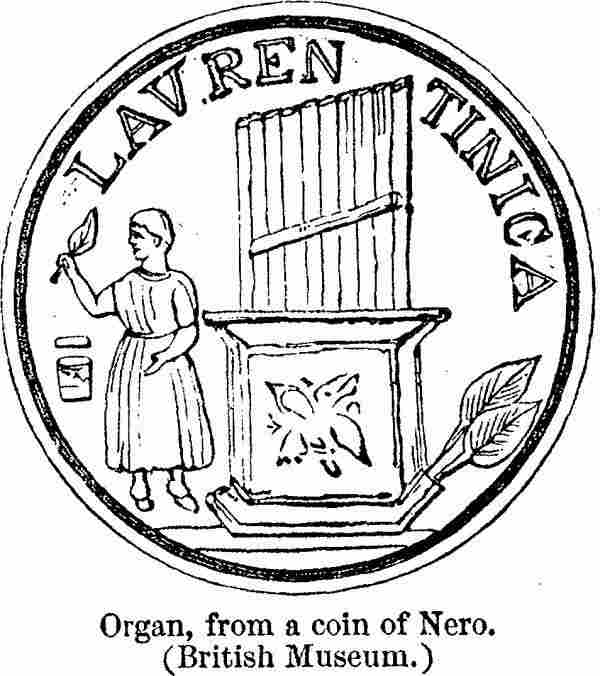.
HYDRAULUS (ὕδραυλος), a water-organ. According to Athenaeus (iv. p. 174 c; cf. Plin. Nat. 7.125), it was the invention of Ctesibius of Alexandria [CTESIBICA MACHINA]. Ctesibius probably lived about B.C. 250, in the reigns of Ptolemy Philadelphus and Euergetes; not, as stated by Athenaeus (ib. p. 174 d), under the second Euergetes 80 years later. He evidently took the idea of his organ from the SYRINX or Pandean pipes, a musical instrument of the highest antiquity among the Greeks. His object being to employ a row of pipes of great size, and capable of emitting the most powerful as well as the softest sounds, he contrived the means of adapting keys with levers (ἀγκωνίσκοι), and with perforated sliders (πώματα), to open and shut the mouths of the pipes (γλωσσόκομα), a supply of wind being obtained, without intermission, by bellows, in which the pressure of water performed the same part which is fulfilled in the modern organ by a weight (Heron, Spirit. 228). On this account the instrument invented by Ctesibius was called the water-organ (ὕδραυλις, Ath. l.c.; ὑδραυλικὸν ὔργανον, Heron, Spirit.; hydraulica machina, Vitr. 10.13; Schneider, ad loc.; Drieberg, Die pneum. Erfindungen der Griechen, pp. 53-61 ; hydraulus, Plin. Nat. 9.24; Cic. Tusc. 3.18, § 43). It is described in an epigram by the Emperor Julian (Brunck, Anal. 2.403=Anth. Pal. 9.365), who mentions the swift fingers of the performer, but not the water-bellows; and more clearly in the following lines of Claudian (de Mall. Theod. Cons. 316-319):-- “ Et qui magna levi detrudens murmura tactu,
Innumeras voces segetis moderatus aënae,
Intonet erranti digito, penitusque trabali
Vecte laborantes in carmina concitet undas.
”
We have here the keys, the innumerable pipes of metal, the lever as large as a beam which sets the water in motion: if we may accept the probable conjecture of Gräbner, pedibus for penitus in 5.318, this lever is moved by a pedal. Its pipes were partly of bronze (χαλκειὴ ἄρουρα, Julian; seges aëna, Claudian), and partly of reed (δόνακες, Julian). The number of its stops, and consequently of its rows of pipes, varied from one to eight (Vitruv. l.c.), so that Tertullian (de Anima, 14) describes it with reason as an exceedingly complicated instrument. The latest account of these water-organs (Grähner, de Hydraulicis veterum Organis, an inaugural dissertation, Berol. 1867) adds little to what was previously known; and we are still in the dark as to the exact part played by the water, which, besides, must have rendered the instrument much less portable. As invented by Ctesibius, the organ was doubtless hydraulic: but the epigram of Julian omits all mention of the water, and we incline to think that, in later times, the mechanism was simplified and the bellows blown directly by the pedal, as in the modern harmonium; the water-power being retained only in the larger organs, which may have been fixtures. The organ figured below from a coin seems too small to allow room for such an arrangement. Mention is made of this instrument so late as the ninth century of our era: in the year 826, a water-organ was erected by a Venetian in the church of Aquisgranum, the modern Aix-la-Chapelle. (Quix, Münsterhirche in Aachen, p. 14.)
The organ was well adapted to gratify the Roman people in the splendid entertainments provided for them by the emperors and other opulent persons. Nero was very curious about organs, both in regard to their musical effect and their mechanism. (Sueton. Ner. 41, 54.) A contorniate coin of this emperor, in the British Museum (see woodcut), shows a small organ with a sprig of laurel on one side, and a man standing on the other, who may have been victorious in the exhibitions of the circus or the amphitheatre. It is probable that these medals were bestowed upon such victors, and that the

Organ, from a coin of Nero. (British Museum.)
organ was impressed upon them on account of its introduction on such occasions. (Havercamp, de Num. contorniatis; Rasche, Lex. Univ. Rei Num. s. v. Hydraulicum Instrumentum.) The general form of the organ is also clearly exhibited in a poem by Publilius Porphyrius Optatianus, describing the instrument, and composed of verses so constructed as to show both the lower part which contained the bellows, the wind-chest which lay upon it, and over this the row of 26 pipes. These are represented by 26 lines, which increase in length each by one letter, until the last line is twice as long as the first. (Wernsdorf, Poetae Lat. Min. vol. ii. pp. 394-413.)
There can be little doubt that ὑδραύλης, hydraula or hydraules, denotes the organist (Suet. Nero 54; Petron. Sat. 36) ; and there is, as has been seen, sufficient evidence that the instrument was keyed and gave scope to the skill of the performer. That the hydraules was one who sang or recited to an accompaniment upon the hydraulic organ has been assumed as part of the theory that these organs were only played by mechanism; a conclusion [p. 1.985]which, we think, raises greater difficulties than it solves.
Dictionary of Greek and Roman Antiquities
| Ancient Greece
Science, Technology , Medicine , Warfare, , Biographies , Life , Cities/Places/Maps , Arts , Literature , Philosophy ,Olympics, Mythology , History , Images Medieval Greece / Byzantine Empire Science, Technology, Arts, , Warfare , Literature, Biographies, Icons, History Modern Greece Cities, Islands, Regions, Fauna/Flora ,Biographies , History , Warfare, Science/Technology, Literature, Music , Arts , Film/Actors , Sport , Fashion --- |


